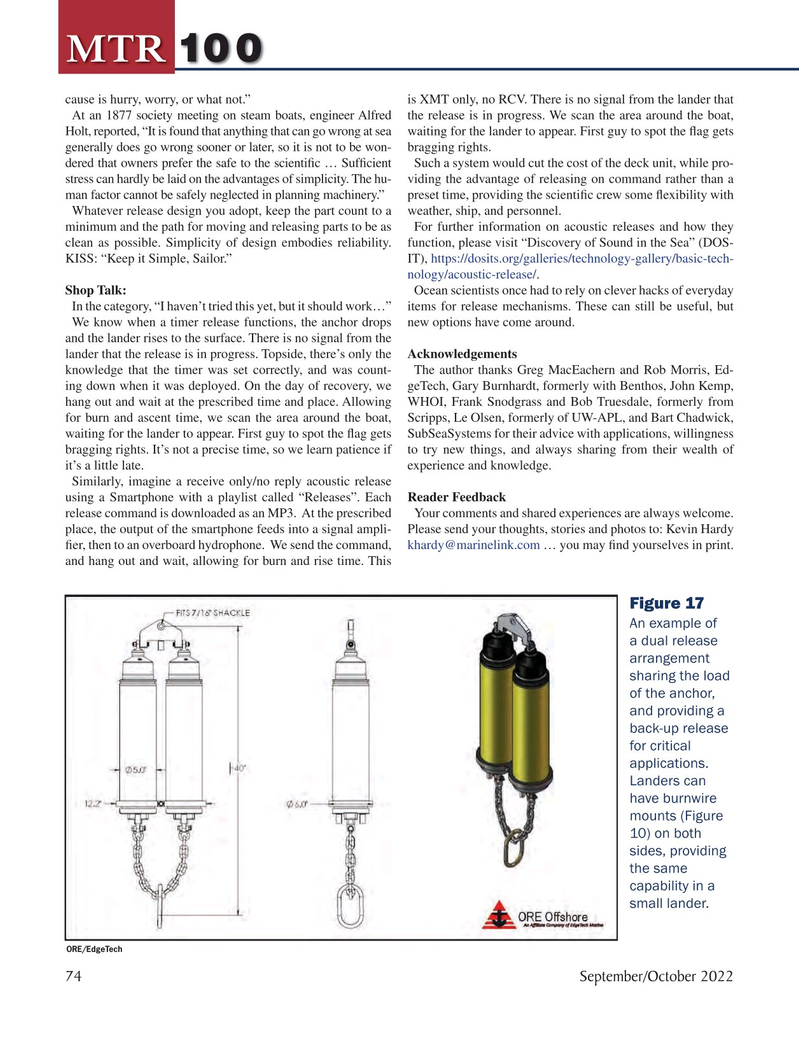
Page 74: of Marine Technology Magazine (September 2022)
Read this page in Pdf, Flash or Html5 edition of September 2022 Marine Technology Magazine
MTR 100 cause is hurry, worry, or what not.” is XMT only, no RCV. There is no signal from the lander that
At an 1877 society meeting on steam boats, engineer Alfred the release is in progress. We scan the area around the boat,
Holt, reported, “It is found that anything that can go wrong at sea waiting for the lander to appear. First guy to spot the ? ag gets generally does go wrong sooner or later, so it is not to be won- bragging rights.
dered that owners prefer the safe to the scienti? c … Suf? cient Such a system would cut the cost of the deck unit, while pro- stress can hardly be laid on the advantages of simplicity. The hu- viding the advantage of releasing on command rather than a man factor cannot be safely neglected in planning machinery.” preset time, providing the scienti? c crew some ? exibility with
Whatever release design you adopt, keep the part count to a weather, ship, and personnel.
minimum and the path for moving and releasing parts to be as For further information on acoustic releases and how they clean as possible. Simplicity of design embodies reliability. function, please visit “Discovery of Sound in the Sea” (DOS-
KISS: “Keep it Simple, Sailor.” IT), https://dosits.org/galleries/technology-gallery/basic-tech- nology/acoustic-release/.
Shop Talk: Ocean scientists once had to rely on clever hacks of everyday
In the category, “I haven’t tried this yet, but it should work…” items for release mechanisms. These can still be useful, but
We know when a timer release functions, the anchor drops new options have come around.
and the lander rises to the surface. There is no signal from the lander that the release is in progress. Topside, there’s only the Acknowledgements knowledge that the timer was set correctly, and was count- The author thanks Greg MacEachern and Rob Morris, Ed- ing down when it was deployed. On the day of recovery, we geTech, Gary Burnhardt, formerly with Benthos, John Kemp, hang out and wait at the prescribed time and place. Allowing WHOI, Frank Snodgrass and Bob Truesdale, formerly from for burn and ascent time, we scan the area around the boat, Scripps, Le Olsen, formerly of UW-APL, and Bart Chadwick, waiting for the lander to appear. First guy to spot the ? ag gets SubSeaSystems for their advice with applications, willingness bragging rights. It’s not a precise time, so we learn patience if to try new things, and always sharing from their wealth of it’s a little late. experience and knowledge.
Similarly, imagine a receive only/no reply acoustic release using a Smartphone with a playlist called “Releases”. Each Reader Feedback release command is downloaded as an MP3. At the prescribed Your comments and shared experiences are always welcome. place, the output of the smartphone feeds into a signal ampli- Please send your thoughts, stories and photos to: Kevin Hardy ? er, then to an overboard hydrophone. We send the command, [email protected] … you may ? nd yourselves in print.
and hang out and wait, allowing for burn and rise time. This
Figure 17
An example of a dual release arrangement sharing the load of the anchor, and providing a back-up release for critical applications.
Landers can have burnwire mounts (Figure 10) on both sides, providing the same capability in a small lander.
ORE/EdgeTech 74 September/October 2022
MTR #7 (66-79).indd 74 9/28/2022 7:20:15 PM

 73
73

 75
75
